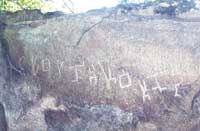|
Gaveshaka
discusses the early days of Sinhala literature Since he was well educated, and knowledgeable, everyone took his advice and acted accordingly. He gained his knowledge by studying in the Pirivena, which was the educational institution of the day. Both laymen and the monks learnt in the Pirivena, which was housed in a leading temple in the area. There were a number of standard text books which were taught in the Pirivena. The first was the ‘Sinhala Hodiya’ - the primary reader, which was used to teach the alphabet. Sinhala, the language of the Sinhalese comes from the same source as other modern North Indian languages like Hindi, Bengali, Marathi, Gujarati and Punjabi. (The Dravidian people who settled in this Island several centuries after the Indo-Aryan people, speak Tamil). Early forms of Sinhala writing is seen in caves where the letters have been inscribed on stone. Looking back in history, after Buddhism was introduced by Arahant Mahinda people in their thousands accepted Buddhism and became Buddhists. Many became monks and started living in jungle caves meditating.
Offerings to the Maha Sangha is referred to as ‘Sanghika’ thus indicating that the offering is for the entire community of monks and not to a particular individual monk. Even in the case of caves, it has been mentioned that they are for the use of monks coming from the four sides. The script found in these cave inscriptions is known as ‘Brahmi’ , which is different to the Sinhala script in use today. Among the more famous inscriptions are those in Vessagiriya in Anuradhapura, Mihintale and Ritigala. The language sees a change by the time the famous Sigiriya graffiti were written. This was after the 5th century. More than 700 verses written by visitors to Sigiriya giving their impressions of the world-renowned frescoes have been identified. The period when Anuradhapura was the capital of ancient Sri Lanka, which extends for over a thousand years is known as the Anuradhapura period. The literary works done during this period is not available except for just two or three. One of them -’Siyabaslakara’ - written in the 9th century is considered the earliest Sinhala literary work, which has been preserved to this day. It is the Sinhala version of a Sanskrit rhetoric written by a king styled Salamevan who has been identified as Sena IV. The classical works done during the Polonnaruwa period (after the capital was shifted to Polonnaruwa from Anuradhapura) between the 11th and 13th century are rated very high. Among these were three acclaimed works of poetry. All three were based on Jataka tales. The oldest is ‘Muvadevdawa’ relating the Makhadeva Jataka. Next comes ‘Sasadava’ based on the Sasa Jataka and the third - ‘Kavsilumina’ ranks as the greatest Sinhala poem. It is based on the Kusa Jataka. The great literary figure, Gurulugomi is credited with two prose works - ‘Dharmapradipika’ and ‘Amavatura’, which are dissimilar in style and subject. While the first shows strong Sanskrit influence, the other is in simple language written in Pali style. In fact, to many, ‘Amavatura’ is the greatest Sinhala prose work. It portrays the life of the Buddha through a series of stories describing the Buddha’s ability to tame the indisciplined. Another work of great merit is ‘Butsarana’ written in the 12th century. |
||||
Copyright © 2001 Wijeya Newspapers
Ltd. All rights reserved. |
 Early
writings seen in caves
Early
writings seen in caves The
early lettering refers to these caves being gifted to monks. As
it happens today, laymen with sufficient wealth or groups of people
build temples and gift them to the Maha Sangha or the fraternity
of monks. We see the names of such donors being mentioned on a plaque
and embedded into the wall in a prominent place for everyone to
see and know who had made that offering to the Sangha and for what
purpose, say in memory of a departed person. In the caves this information
was generally mentioned below the drip-ledge.
The
early lettering refers to these caves being gifted to monks. As
it happens today, laymen with sufficient wealth or groups of people
build temples and gift them to the Maha Sangha or the fraternity
of monks. We see the names of such donors being mentioned on a plaque
and embedded into the wall in a prominent place for everyone to
see and know who had made that offering to the Sangha and for what
purpose, say in memory of a departed person. In the caves this information
was generally mentioned below the drip-ledge.